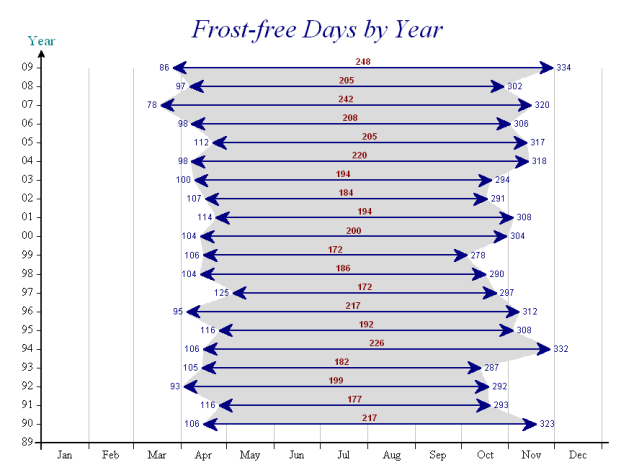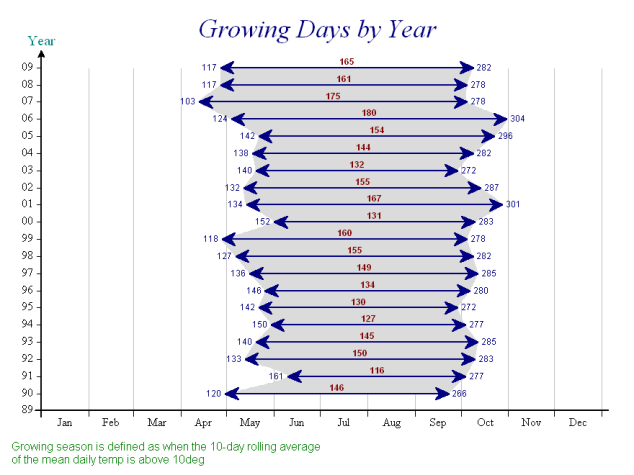Back to the Annual Report Contents and Home page
One of the most-noticed features of recent years has been the apparent advance of spring, with Snowdrops and Primroses getting reported earlier and earlier. It is very hard to filter out the ‘observer bias’ from this sort of ad-hoc reportage, so I thought it would be interesting to see if any patterns are emerging in our long-term records.
The easiest chart to plot is simply to take the run of frost-free days year by year:

This simply shows the span of days from the last frost (temperature zero or below) of spring to the first frost of autumn. Rather oddly, 2009 scored really well with the latest autum frost we have had, in spite of the very long cold winter! As you can see, there is a sporadic advance of spring, but not a desperately clear pattern in autumn. You would be hard-pressed to publish a scientific paper with only this chart for backing.
What else might we look at to get a better idea of whether the temperature data supports the perceived early start of the spring flowering? The key factor in getting anything to grow is soil temperature which is always going to lag a little way behind the daily air temperature, and is also going to blur out sharp changes like a 2-day warm spell. Things will start to grow as soon as their roots see a temperature of around 10°C. Soil is a surprisingly good insulator, and the general view seems to be that the lag is about 10 days, so how about a plot of the period when the rolling average of the daily mean temperature gets above the magic 10°:

Still not clear? Well there are some good headline numbers we could dig out of this one – anything above 160 was rare in the 1990s with just the one hit in 1999, and suddenly we got 4 in a row! You definitely get the sense that the shaded area is getting fatter as you move up the page, but all that ducking and diving makes it really hard to be sure there is a true pattern here. Now you can see why climate science is a tricky place to work! Let’s just pull the numbers out and do a simple scatterplot against year to see how it comes out:

By fitting a simple cubic model to the numbers, we can make this look much more plausible. Nothing much changes in the early 1990s, then we have a very solid linear trend of just over 2 extra days per year (30 extra growing days in 14 years) which really is a very significant movement. Just think of it as having to cut the lawn 10 more times!
It will be very interesting to get the numbers for 2010 – winter is definitely still with us, but if April mirrors December we could flip straight through to summer with hardly a sniff of a normal spring. As anyone who watched “The Day after Tomorrow” will know, the first effect of global warming on north-west Europe is to cut out the North Atlantic Drift and make our winters a lot more continental. Like the one we have just had, in fact.
© Adrian Smith & Ryedale Natural History Society 2010
Back to the Annual Report Contents and Home page